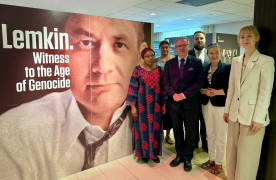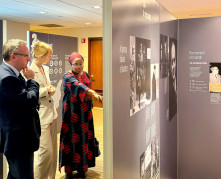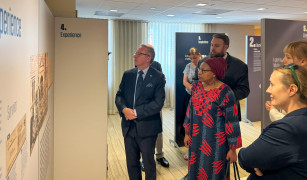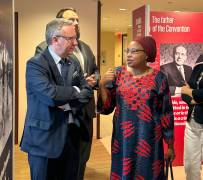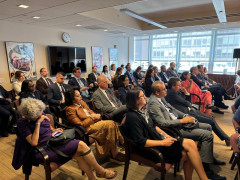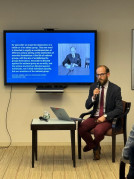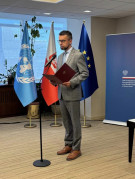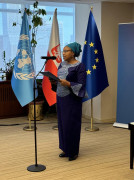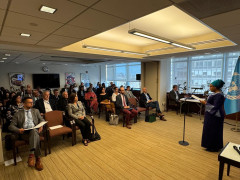The Pilecki Institute’s “Lemkin. Witness to the Age of Genocide” exhibition has opened for the second time in New York - Instytut Pileckiego
04.09.2024 (Wed)
The Pilecki Institute’s “Lemkin. Witness to the Age of Genocide” exhibition has opened for the second time in New York - Instytut Pileckiego
To commemorate Raphael Lemkin on the 65th anniversary of his passing, the exhibition “Lemkin. Witness to the Age of Genocide” was displayed at the Permanent Mission of the Republic of Poland to the United Nations in New York.
The opening of the exhibition in New York is a symbolic return to the location in which Lemkin worked on the most important mission of his life. The exhibition “Lemkin. Witness to the Age of Genocide” was first displayed in New York in 2019 (read about the event here). Five years later, the exhibition is once again available to visitors from 28 August 2024 to 13 September 2024.
The first visitors were Alice Wairimu Nderitu (the United Nations Special Adviser on the Prevention of Genocide to United Nations Secretary-General) and Ambassador Krzysztof Szczerski (Permanent Representative of the Republic of Poland to the United Nations in New York and the exhibition’s organizer). Prior to visiting the exhibition, they laid flowers on Raphael Lemkin’s gravestone at the Mount Hebron cemetery in New York.
On 3 September 2014, during the meeting devoted to the exhibition, Bartosz Gralicki from the Pilecki Insitute’s Exhibitions Department delivered a lecture entitled Raphael Lemkin. Lawyer, refugee, witness to the age of genocide. Among the participants were Alice Wairimu Nderitu (the United Nations Special Adviser on the Prevention of Genocide to United Nations Secretary-General), Michał Miarka (Deputy Permanent Representative of the Republic of Poland to the United Nations in New York), and numerous accredited representatives of the United Nations Organization.
Raphael Lemkin was one of the most important lawyers of the 20th century. It is to his efforts that we owe not only the concept of genocide itself, but also the Convention on the Prevention and Punishment of the Crime of Genocide, which was adopted by the United Nations on 9 December 1948. It was the first international human rights treaty after the Second World War.
Raphael Lemkin was deeply rooted in pre-war Poland and its intellectual milieu. Inspirations from the Lwów school of law, the tradition of the multi-national and multicultural Polish Republic, the experience of the confrontation with two totalitarian regimes in the 20th century – all these factors substantially contributed to Lemkin’s concept of genocide. It is one of the most significant answers to the great tragedies of the 20th century, one based on law and political philosophy.
Genocide is an ever-present and recurring tragedy of mankind. The phenomenon itself received a name and a legal definition in as late as the 20th century, and the end of the most terrible of world wars failed to put a stop to it. New instances of genocide continue to occur in various parts of the globe.
In the theory and philosophy of law and politics, the problem of genocide remains a fundamental and pressing issue of the human rights law. It is also connected with the question about the nature of community and protected human values, as well as with the right to a peaceful coexistence. This issue, which is a matter of concern for politicians, diplomats, and people of the media and culture, pertains to entire nations all over the world.
